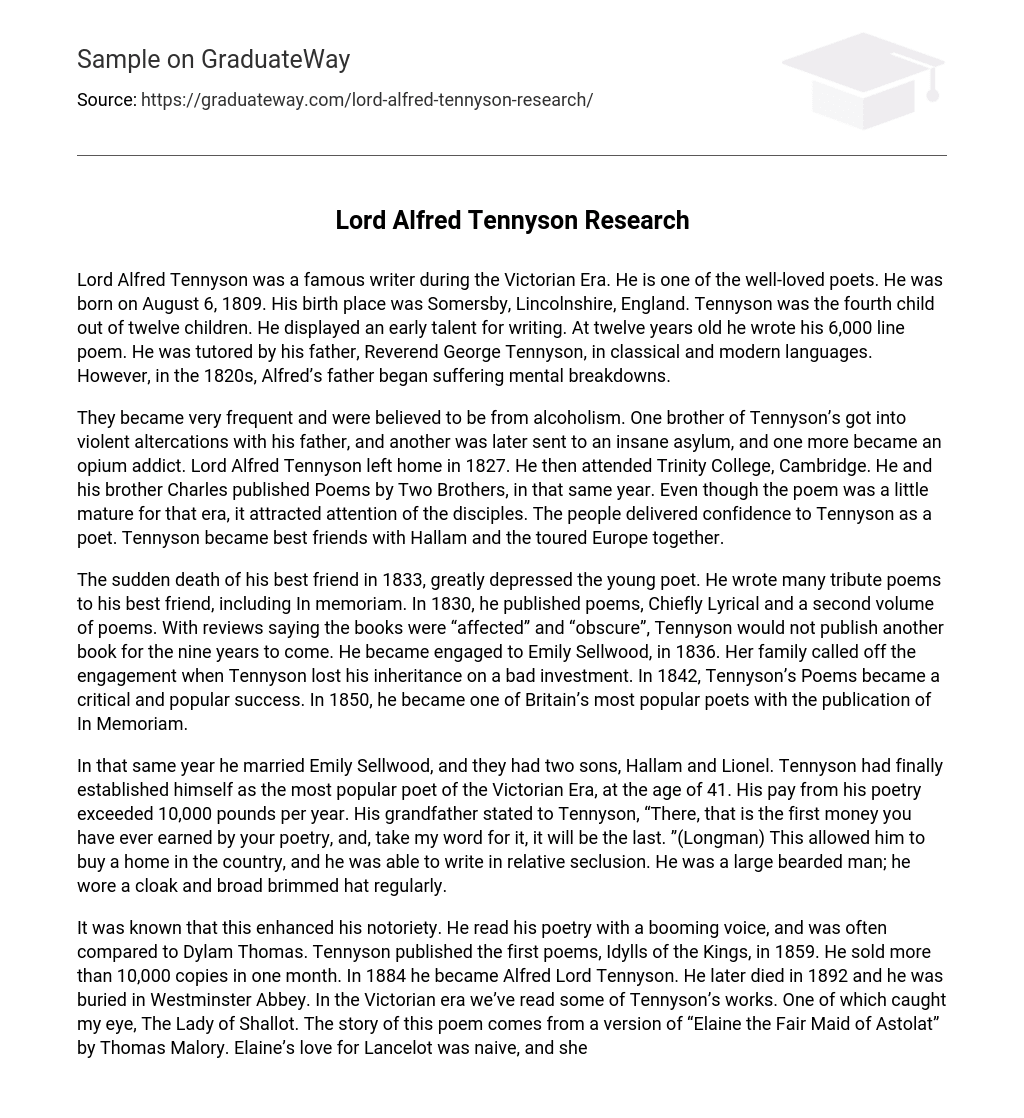Lord Alfred Tennyson, born on August 6, 1809 in Somersby, Lincolnshire, England, was a celebrated writer during the Victorian Era and a beloved poet. He was the fourth child among twelve children and displayed his talent for writing from an early age. By twelve years old, he had already written a poem comprising of 6,000 lines. Reverend George Tennyson, his father, provided him with education in classical and modern languages; however, during the 1820s, Alfred’s father suffered from mental breakdowns.
Tennyson’s family witnessed disturbing behavior caused by frequent alcoholism. One sibling engaged in violent confrontations with their father, another was admitted to a mental institution, and yet another developed an addiction to opium. In 1827, Lord Alfred Tennyson left his home and started studying at Trinity College, Cambridge. During the same year, he and his brother Charles jointly published Poems by Two Brothers which attracted readers’ attention and helped establish Tennyson as a talented poet of that era. Throughout this time period, Tennyson forged a close friendship with Hallam and they embarked on journeys together throughout Europe.
In 1833, the young poet experienced profound sadness when his closest friend suddenly died. In memory of his companion, he wrote a series of tribute poems, including “In Memoriam”. In 1830, he published two volumes of verse called “Chiefly Lyrical” and another volume. Unfortunately, these books received negative reviews where critics criticized them as being “affected” and “obscure”. Consequently, the poet decided not to publish any more works for almost nine years. However, in 1836 he became engaged to Emily Sellwood; nevertheless, her family ended the engagement due to an unfortunate investment loss that caused him to lose his inheritance. Nevertheless, things took a turn for the better in 1842 when Tennyson’s poetry book garnered both critical acclaim and widespread popularity. This marked a turning point that propelled him into becoming one of Britain’s most beloved poets—a status that was further solidified with the release of “In Memoriam” in 1850.
Tennyson married Emily Sellwood in the same year and had two sons, Hallam and Lionel. By the age of 41, Tennyson became the most popular poet of the Victorian Era, earning over 10,000 pounds annually from his poetry. His financial success surprised even his grandfather who remarked “There, that is the first money you have ever earned by your poetry, and, take my word for it, it will be the last” (Longman). With his newfound wealth, he bought a country home where he could write in solitude. Tennyson was renowned for his large beard and often appeared in public donning a cloak and broad-brimmed hat.
Alfred Lord Tennyson, renowned for his commanding voice, gained renown from reciting his poetry. In 1859, he released his debut collection, “Idylls of the Kings,” which astonishingly sold over 10,000 copies in just a month. By 1884, Tennyson assumed the title of Alfred Lord and continued writing until his demise in 1892. He was interred at Westminster Abbey. During the Victorian era, readers were captivated by Tennyson’s works, especially “The Lady of Shallot,” a poem inspired by Thomas Malory’s rendition of “Elaine the Fair Maid of Astolat.” Tragically, Elaine’s pure love for Lancelot ultimately resulted in her untimely death due to heartbreak.
Tennyson composed a lengthy poem that was seemingly influenced by a narrative. In 1832, he penned the initial rendition and asserted that it drew inspiration from an ancient Italian romance rather than Thomas Malory’s tale. The ultimate iteration of the poem was released in 1842. It narrates the story of a lady residing in a tower on Shallot Island, situated alongside a river running parallel to the path leading to Camelot. The backdrop of this poem bears resemblance to the legends surrounding King Arthur and his Round Table knights.
The Lady of Shallot is confined by “four grey walls, and four grey towers” (Longman). Each day, she weaves a tapestry showcasing the landscape, which includes Camelot, from her window. However, a curse prevents her from directly observing the outside world. Despite being unaware of the reason behind her curse, she continues to create artwork with the aid of a mirror beside her. While she finds contentment in her weaving, she grows tired of solely experiencing life through reflections. One fateful day, as Sir Lancelot passes by, she cannot resist looking directly at him through the window. In that moment, she becomes conscious that the curse has afflicted her. After this realization dawns upon her, she leaves her tower and encounters a boat at the river.
She writes “The Lady of Shallot” on the side. Then, she floats down the river towards Camelot while singing and observing previously forbidden sights. Eventually, she dies. As the boat passes by Camelot, all knights make a cross sign upon seeing her body. However, Lancelot remarks “She has a lovely face.” (Longman) The theme of this story varies depending on the reader’s interpretation. Personally, I took away seclusion as the lady of Shalott is cursed to remain in a tower and isolated from social life.
Based on his own desires and requirements, Tennyson crafted this poem. By isolating himself, Tennyson deliberately sought solace and freedom from disturbances and social connections. He apprehended that such engagement with society would jeopardize his creative drive for composing poetry. It was imperative for him to detach himself from life’s diversions in order to effectively transmute existence into art. The same principle applies to the lady of shalott. Tennyson has intertwined his own existence within the poem, granting us enhanced insight into life as perceived by the poet.
Lord Alfred Tennyson was not only a talented poet but also a naturalist, as his writing style demonstrated. His dedication to writing popular poetry for the people made him one of the most beloved Victorian era poets.





